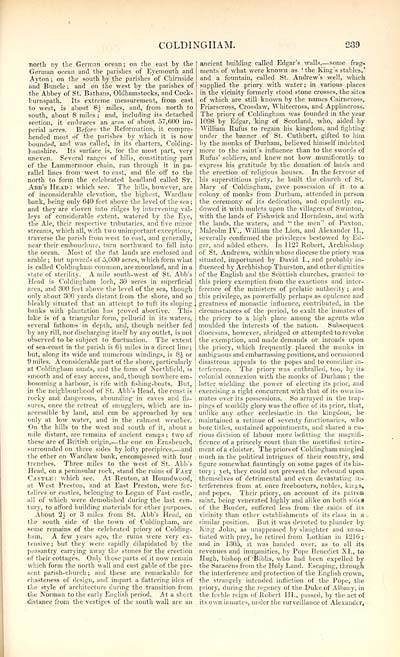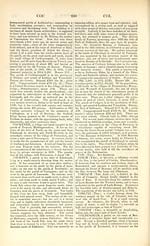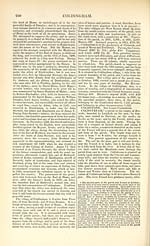Topographical, statistical, and historical gazetteer of Scotland > Volume 1
(319) Page 239 - COL
Download files
Complete book:
Individual page:
Thumbnail gallery: Grid view | List view

COLDINGHAM.
239
north uy tlie German ocean; on the east by the
German ocean and the parishes of Eyemouth and
Ayton ; on the south by the parishes of Chirnside
and Buncle ; and on the west by the parishes of
the Abbey of St. Bathans, Oldlmmstocks, and Cock-
burnspath. Its extreme measurement, from east
to west, is about 8 3 miles, and, from north to
south, about 8 miles f and, including its detached
section, it embraces an area of about 57,600 im-
perial acres. Before the Reformation, it compre-
hended most of the parishes by which it is now
bounded, and was called, in its charters, Colding-
hamshire. Its surface is, for the most part, very
uneven. Several ranges of hills, constituting part
of the Lammermoor chain, run through it in pa-
rallel lines from west to east, and file off to the
north to form the celebrated headland called St.
Abb's Head : which see. The hills, however, are
of inconsiderable elevation, the highest, Wardlaw'
bank, being only 640 feet above the level of the sea;
and they are cloven into ridges by intervening val-
leys of considerable extent, watered by the Eye,
the Ale, their respective tributaries, and five minor
streams, which all, with two unimportant exceptions,
traverse the parish from west to east, and generally,
near their embouchure, turn northward to fall into
the ocean. Most of the flat lands are enclosed and
arable ; but upwards of 5,000 acres, which form what
is called Coldingham common, are moorland, and in a
state of sterility. A mile south-west of St. Abb's
Head is Coldingham loch, 30 acres in superficial
area, and 300 feet above the level of the sea, though
only about 300 yards distant from the shore, and so
bleakly situated that an attempt to tuft its sloping
banks with plantation has proved abortive. This
lake is of a triangular form, pellucid in its waters,
several fathoms in depth, and, though neither fed
by any rill, nor discharging itself by any outlet, is not
observed to be subject to fluctuation. The extent
of sea-coast in the parish is 6.7 miles in a direct line ;
but, along its wide and numerous windings, is 8i or
9 miles. A considerable part of the shore, particularly
at Coldingham sands, and the farm of Is'orthfield, is
smooth and of easy access, and, though nowhere em-
bosoming a harbour, is rife with fishing-boats. But,
in the neighbourhood of St. Abb's Head, the coast is
rocky and dangerous, abounding in caves and fis-
sures, once the retreat of smugglers, which are in-
accessible by land, and can be approached by sea !
only at low water, and in the calmest weather.
On the hills to the west and south of it, about a
mile distant, are remains of ancient camps ; two of
these are of British origin, ~— the one on Ernsheuch,
surrounded on three sides by lofty precipices, — and
the other on Wardlaw bank, encompassed with four
trenches. Three miles to the west of St. Abb's
Head, on a peninsular rock, stand the ruins of Fast
Castle: which see. At Renton, at Houndwood, j
at West Preston, and at East Preston, were for-
talices or castles, belonging to Logan of Fast castle,
all of which were demoUshed during the last cen-
tury, to afford building materials for other purposes.
About 2| or 3 miles from St. Abb's Head, on
the south side of the town of Coldingham, are
some remains of the celebrated priory of Colding-
ham. A few years ago, the ruins were very ex-
tensive; but they were rapidly dilapidated by the
peasantry carrying away the stones for the erection
of their cottages. Only those parts of it now remain
which form the north wall and east gable of the pre-
sent parish-church ; and these are remarkable for
chasteness of design, and impart a flattering idea of
the style of architecture during the transition from
the Norman to the early English period. At a short
distance from the vestiges of the south wall are an
ancient building called Edgar's walls, — some frag,
ments of what were known as ' the King's stables,'
and a fountain, called St. Andrew's well, which
supplied the priory with water ; in various places
in the vicinity formerly stood stone crosses, the sites
of which are still known by the names Cairncross,
Friarscross, Crosslaw, Whitecross, and Applincross.
The priory of Coldingham was founded in the year
1098 by Edgar, king of Scotland, who, aided by
William Rufus to regain his kingdom, and fighting
under the banner of St. Cuthbert, gifted to him
by the monks of Durham, believed himself indebted
more to the saint's influence than to the swords of
Rufus' soldiers, and knew not how munificently to
express his gratitude by the donation of lauds and
the erection of religious houses. In the fervour of
his superstitious piety, he built the church of St.
Mary of Coldingham, gave possession of it to a
colony of monks from Durham, attended in person
the ceremony of its dedication, and opulently en-
dowed it with mulcts upon the villagers of Swinton,
with the lands of Fishwick and Horndean, and with
the lands, the waters, and "the men" of Paxton.
Malcolm IV., WilUam the Lion, and Alexander II.,
severally confirmed the privileges bestowed by Ed-
gar, and added others. In 1127 Robert, Archbishop
of St. Andrews, within whose diocese the priory was
situated, importuned by David I., and probably in-
fluenced by Archbishop Thurston, and other dignities
of the English and the Scottish churches, granted to
this priory exemption from the exactions and inter-
ference of the ministers of prelatic authority ; and
this privilege, as powerfully perhaps as opulence and
greatness of monastic influence, contributed, in the
circumstances of the period, to exalt the inmates of
the priory to a high place among the agents who
moulded the interests of the nation. Subsequent
diocesans, however, abridged or attempted to revoke
the exemption, and made demands or inroads upon
the priory, which frequently placed the monks in
ambiguous and embarrassing positions, and occasioned
disastrous appeals to the popes and to conciliar in-
terference. The priory was enthralled, too, by its
colonial connexion with the monks of Durham ; the
latter wielding the power of electing its prior, and
exercising a right concurrent with that of its own in-
mates over its possessions. So arrayed in the trap-
pings of worldly glory was the office of its prior, that,
unlike any other ecclesiastic in the kingdom, he
maintained a retinue of seventy functionaries, who
bore titles, sustained appointments, and shared a cu-
rious division of labour more befitting the magnifi-
ficence of a princely court than the mortified retire-
ment of a cloister. The priors of Coldingham mingled
much in the political intrigues of their country, and
figure somewhat flauntingly on some pages of its his-
tory ; yet, they could not prevent the rebound upon
themselves of detrimental and even devastating in-
terferences from at once freebooters, nobles, king s,
and popes. Their priory, on account of its patron
saint, being venerated highly and alike on both sirits
of the Border, suffered less from the raids of its
vicinity than other establishments of its class in a j
similar position. But it was devoted to plunder by
King John, as unappeased by slaughter and unsa-
tiated with prey, he retired from Lothian in 1216;
and in 1305, it was handed over, as to all its
revenues and imnjunities, by Pope Benedict XL, to
Hugh, bishop of -Biblis, who had been expelled by
the Saracens from the Holy Land. Escaping, through
the interference and protection of the English crown,
the strangely intended infliction of the Pope, the
priory, during the regency of the Duke of Albany; in
the feeble reign of Robert III., passed, by the act of
its own inmates, under the surveillance of Alexander,
239
north uy tlie German ocean; on the east by the
German ocean and the parishes of Eyemouth and
Ayton ; on the south by the parishes of Chirnside
and Buncle ; and on the west by the parishes of
the Abbey of St. Bathans, Oldlmmstocks, and Cock-
burnspath. Its extreme measurement, from east
to west, is about 8 3 miles, and, from north to
south, about 8 miles f and, including its detached
section, it embraces an area of about 57,600 im-
perial acres. Before the Reformation, it compre-
hended most of the parishes by which it is now
bounded, and was called, in its charters, Colding-
hamshire. Its surface is, for the most part, very
uneven. Several ranges of hills, constituting part
of the Lammermoor chain, run through it in pa-
rallel lines from west to east, and file off to the
north to form the celebrated headland called St.
Abb's Head : which see. The hills, however, are
of inconsiderable elevation, the highest, Wardlaw'
bank, being only 640 feet above the level of the sea;
and they are cloven into ridges by intervening val-
leys of considerable extent, watered by the Eye,
the Ale, their respective tributaries, and five minor
streams, which all, with two unimportant exceptions,
traverse the parish from west to east, and generally,
near their embouchure, turn northward to fall into
the ocean. Most of the flat lands are enclosed and
arable ; but upwards of 5,000 acres, which form what
is called Coldingham common, are moorland, and in a
state of sterility. A mile south-west of St. Abb's
Head is Coldingham loch, 30 acres in superficial
area, and 300 feet above the level of the sea, though
only about 300 yards distant from the shore, and so
bleakly situated that an attempt to tuft its sloping
banks with plantation has proved abortive. This
lake is of a triangular form, pellucid in its waters,
several fathoms in depth, and, though neither fed
by any rill, nor discharging itself by any outlet, is not
observed to be subject to fluctuation. The extent
of sea-coast in the parish is 6.7 miles in a direct line ;
but, along its wide and numerous windings, is 8i or
9 miles. A considerable part of the shore, particularly
at Coldingham sands, and the farm of Is'orthfield, is
smooth and of easy access, and, though nowhere em-
bosoming a harbour, is rife with fishing-boats. But,
in the neighbourhood of St. Abb's Head, the coast is
rocky and dangerous, abounding in caves and fis-
sures, once the retreat of smugglers, which are in-
accessible by land, and can be approached by sea !
only at low water, and in the calmest weather.
On the hills to the west and south of it, about a
mile distant, are remains of ancient camps ; two of
these are of British origin, ~— the one on Ernsheuch,
surrounded on three sides by lofty precipices, — and
the other on Wardlaw bank, encompassed with four
trenches. Three miles to the west of St. Abb's
Head, on a peninsular rock, stand the ruins of Fast
Castle: which see. At Renton, at Houndwood, j
at West Preston, and at East Preston, were for-
talices or castles, belonging to Logan of Fast castle,
all of which were demoUshed during the last cen-
tury, to afford building materials for other purposes.
About 2| or 3 miles from St. Abb's Head, on
the south side of the town of Coldingham, are
some remains of the celebrated priory of Colding-
ham. A few years ago, the ruins were very ex-
tensive; but they were rapidly dilapidated by the
peasantry carrying away the stones for the erection
of their cottages. Only those parts of it now remain
which form the north wall and east gable of the pre-
sent parish-church ; and these are remarkable for
chasteness of design, and impart a flattering idea of
the style of architecture during the transition from
the Norman to the early English period. At a short
distance from the vestiges of the south wall are an
ancient building called Edgar's walls, — some frag,
ments of what were known as ' the King's stables,'
and a fountain, called St. Andrew's well, which
supplied the priory with water ; in various places
in the vicinity formerly stood stone crosses, the sites
of which are still known by the names Cairncross,
Friarscross, Crosslaw, Whitecross, and Applincross.
The priory of Coldingham was founded in the year
1098 by Edgar, king of Scotland, who, aided by
William Rufus to regain his kingdom, and fighting
under the banner of St. Cuthbert, gifted to him
by the monks of Durham, believed himself indebted
more to the saint's influence than to the swords of
Rufus' soldiers, and knew not how munificently to
express his gratitude by the donation of lauds and
the erection of religious houses. In the fervour of
his superstitious piety, he built the church of St.
Mary of Coldingham, gave possession of it to a
colony of monks from Durham, attended in person
the ceremony of its dedication, and opulently en-
dowed it with mulcts upon the villagers of Swinton,
with the lands of Fishwick and Horndean, and with
the lands, the waters, and "the men" of Paxton.
Malcolm IV., WilUam the Lion, and Alexander II.,
severally confirmed the privileges bestowed by Ed-
gar, and added others. In 1127 Robert, Archbishop
of St. Andrews, within whose diocese the priory was
situated, importuned by David I., and probably in-
fluenced by Archbishop Thurston, and other dignities
of the English and the Scottish churches, granted to
this priory exemption from the exactions and inter-
ference of the ministers of prelatic authority ; and
this privilege, as powerfully perhaps as opulence and
greatness of monastic influence, contributed, in the
circumstances of the period, to exalt the inmates of
the priory to a high place among the agents who
moulded the interests of the nation. Subsequent
diocesans, however, abridged or attempted to revoke
the exemption, and made demands or inroads upon
the priory, which frequently placed the monks in
ambiguous and embarrassing positions, and occasioned
disastrous appeals to the popes and to conciliar in-
terference. The priory was enthralled, too, by its
colonial connexion with the monks of Durham ; the
latter wielding the power of electing its prior, and
exercising a right concurrent with that of its own in-
mates over its possessions. So arrayed in the trap-
pings of worldly glory was the office of its prior, that,
unlike any other ecclesiastic in the kingdom, he
maintained a retinue of seventy functionaries, who
bore titles, sustained appointments, and shared a cu-
rious division of labour more befitting the magnifi-
ficence of a princely court than the mortified retire-
ment of a cloister. The priors of Coldingham mingled
much in the political intrigues of their country, and
figure somewhat flauntingly on some pages of its his-
tory ; yet, they could not prevent the rebound upon
themselves of detrimental and even devastating in-
terferences from at once freebooters, nobles, king s,
and popes. Their priory, on account of its patron
saint, being venerated highly and alike on both sirits
of the Border, suffered less from the raids of its
vicinity than other establishments of its class in a j
similar position. But it was devoted to plunder by
King John, as unappeased by slaughter and unsa-
tiated with prey, he retired from Lothian in 1216;
and in 1305, it was handed over, as to all its
revenues and imnjunities, by Pope Benedict XL, to
Hugh, bishop of -Biblis, who had been expelled by
the Saracens from the Holy Land. Escaping, through
the interference and protection of the English crown,
the strangely intended infliction of the Pope, the
priory, during the regency of the Duke of Albany; in
the feeble reign of Robert III., passed, by the act of
its own inmates, under the surveillance of Alexander,
Set display mode to: Large image | Transcription
Images and transcriptions on this page, including medium image downloads, may be used under the Creative Commons Attribution 4.0 International Licence unless otherwise stated. ![]()
| Gazetteers of Scotland, 1803-1901 > Topographical, statistical, and historical gazetteer of Scotland > Volume 1 > (319) Page 239 - COL |
|---|
| Permanent URL | https://digital.nls.uk/97441374 |
|---|
| Description | Volume first. A-H. |
|---|---|
| Attribution and copyright: |
|

